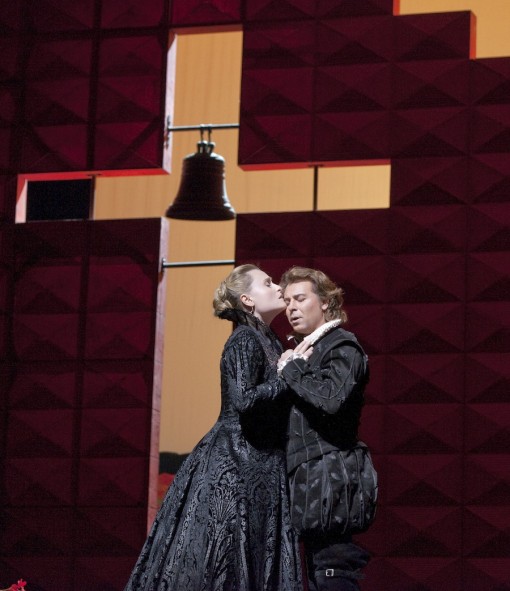The Met delivers a powerful, moving and very Catholic “Don Carlo”

Marina Poplavskaya as Elisabeth and Roberto Alagna in the title role of Verdi's "Don Carlo." Photo: Ken Howard/Metropolitan Opera
“How was it for you?” a young man asked his companion as they lined up at the bar during the second intermission of Monday night’s new production of Don Carlo. Moments before, Philip II had dispatched a bloodied band of heretics to the stake in a gory auto-da-fé.
“I liked it,” replied the other, a pallid youth with longish blond hair. “I like Jesus and fire, so I was pretty much on board.”
A taste for the more lurid expressions of Catholic devotion may be required to fully appreciate this Don Carlo, which premiered at Covent Garden two years ago, directed by Nicholas Hytner, director of London’s National Theater and designed by Bob Crowley, an Irishman. Mr. Crowley dug deep into the repository of Christian kitsch with sets that sometimes looked like the sort of devotional souvenirs sold to pilgrims in Santiago de Compostela. During the auto-da-fé, the fulcral point of the opera, an entire wall was given over to a painting of a pudgy-looking Christ with blood dripping down his forehead; the model of Valladolid Cathedral was doused in gold paint, looking like something from inside a snow globe.
That the production nevertheless offers a powerful and moving portrayal of Verdi’ s darkest and most complex opera is a measure of the vocal brilliance of the cast, the driving force of Yannick Nézet-Séguin’s conducting, and – to a degree rarely felt in opera – the virtuosic lighting by Mark Henderson. When Don Carlo first visits the tomb of his grandfather Charles V in the monastery, Henderson creates a criss-cross of light beams that suggest the nightmarish stairways of Piranesi’s Carceri. Much of the time, the lighting moves as fluidly as the music, inflecting a single scene with a wide spectrum of moods. And when the admonishing ghost of Charles appears at the end of the opera, he does so in a burst of glaring light so operatic it seems an extension of Verdi’s orchestration.
The production is based on the 1886 Modena version of Don Carlo, consisting of the final revised edition by Verdi but including also the initial Fontainebleau scene in which Don Carlo and Elisabetta first meet. This makes for a long evening, but Nézet-Séguin’s muscular tempos kept the momentum going. Much of his popular appeal lies in his technique, the sort of conducting that is engaging to watch for its infectious energy.
But the sounds he drew out of the Met orchestra proved once again that he is a very serious musician. In scene after scene, he built up dramatic tension through the use of bold blocks of color like the musical equivalent of chiaroscuro painting. He is well attuned to the stage directions embedded in the score, such as the menacing limp of the Grand Inquisitor, sung with a powerful, if wobbly, bass by Eric Halfvarson.
Ferruccio Furlanetto offered a searing performance as Philip II. His voice is evenly round and majestic across the register and his heart-wrenching Ella giammai m’amò brought a prolonged storm of applause. The moving portrayal of the tyrant’s private grief was marred only by the presence of a gilded reliquary in the corner with a garish image of a saint peering out like a jack-in-the-box.
Carlo was sung by Roberto Alagna; his revolutionary friend Rodrigo by Simon Keenlyside. Alagna’s appearance had been much anticipated, but, echoing events in the opera, the true heir to Furlanetto’s vocal reign seemed to be Keenlyside. The English baritone was in glorious form making the most of Verdi’s luscious melodies and producing a warm, vibrant tone even when he sang the beginning of Io morrò lying face-down on the floor.
Alagna produced all the notes required of him, but appeared slow in warming to his role. His middle register has at times a sharp, somewhat ungenerous quality about it and some of his high notes stood out more for their loudness than anything else. But he played the part of the impetuous prince with great conviction and there was genuine chemistry between him and Marina Poplavskaya’s Elisabetta.
Poplavskaya is gifted with a scintillating vocal personality and knows how to apply it. When she pulls out all the stops she produces a rich, creamy sound, but she also knows how to pare it down to a purer, more youthful and fragile tone. As Elisabetta, she drew on both, showing the womanly, sensuous side of the young queen, and the hard fought-for peace as she renounces her passion. In the garden scene in Act I, when she forces herself to reject Carlo’s advances causing him to faint in her arms, Poplavskaya resorts to half speaking, half singing to him for a few lines, offering a moment of rare intimacy amid the pomp and drama.
By contrast, Anna Smirnova’s Eboli is all fire. Her veil song suffered from an excess of vibrato, though it helped sketch out a character simmering with passion and resentment, and she nicely brought out the Moorish character of the melody. Her O don fatale showcased her flexible coloratura technique in an explosive portrayal of self-incrimination and remorse. As an auto-da-fe, it was a lot more chilling than any assembly of barefoot heretics and hooded monks.
Don Carlo will be reprised with the same cast on December 7 and 11 and with Yonghoon Lee in the title role on November 29 and December 3, 15 and 18. 212-362-6000; metopera.org.